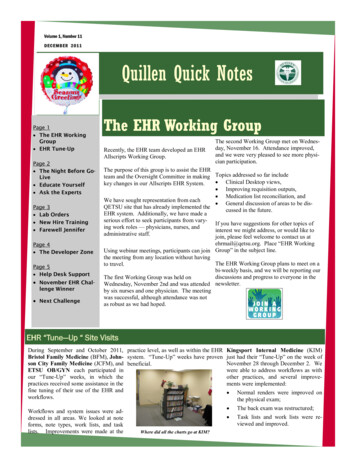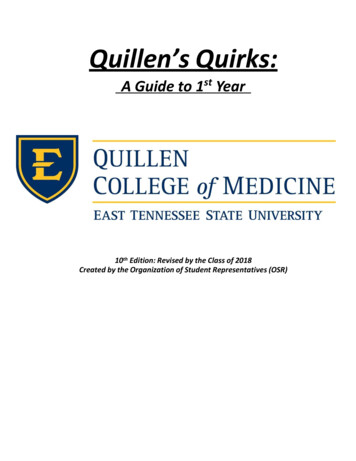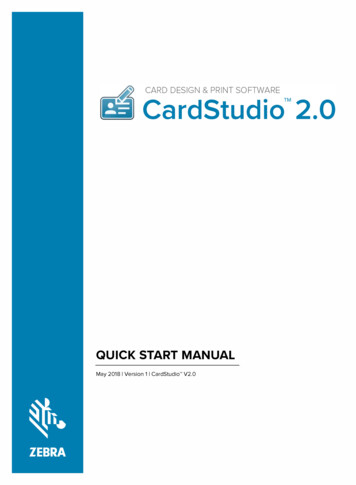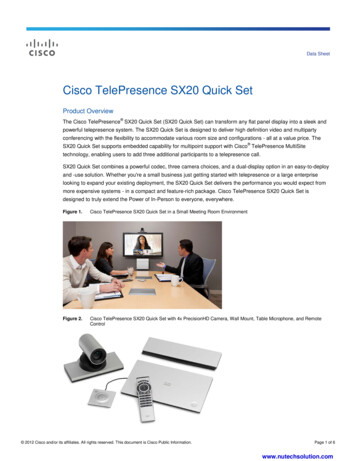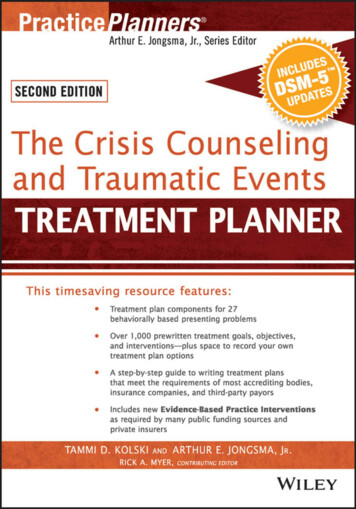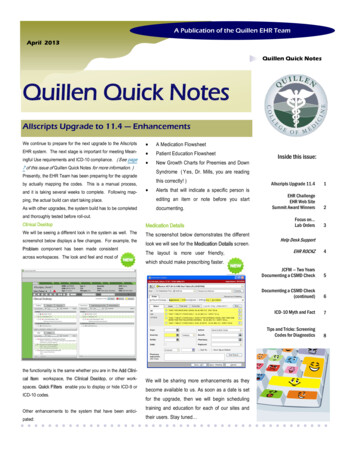
Transcription
A Publication of the Quillen EHR TeamApril 2013Quillen Quick NotesQuillen Quick NotesAllscripts Upgrade to 11.4 — EnhancementsWe continue to prepare for the next upgrade to the Allscripts A Medication FlowsheetEHR system. The next stage is important for meeting Mean- Patient Education Flowsheet New Growth Charts for Preemies and Downingful Use requirements and ICD-10 compliance. ( See page7 of this issue of Quillen Quick Notes for more information. )Syndrome ( Yes, Dr. Mills, you are readingPresently, the EHR Team has been preparing for the upgradeby actually mapping the codes. This is a manual process,and it is taking several weeks to complete. Following map-Inside this issue:this correctly! ) Alerts that will indicate a specific person isAllscripts Upgrade 11.4123ping, the actual build can start taking place.editing an item or note before you startAs with other upgrades, the system build has to be completeddocumenting.EHR ChallengeEHR Web SiteSummit Award WinnersClinical DesktopMedication DetailsFocus on.Lab OrdersWe will be seeing a different look in the system as well. TheThe screenshot below demonstrates the differentand thoroughly tested before roll-out.screenshot below displays a few changes. For example, theProblem component has been made consistentacross workspaces. The look and feel and most oflook we will see for the Medication Details screen.The layout is more user friendly,spaces. Quick Filters enable you to display or hide ICD-9 orICD-10 codes.Other enhancements to the system that have been anticipated:EHR ROCKZ4JCFM — Two YearsDocumenting a CSMD Check5Documenting a CSMD Check(continued)6ICD-10 Myth and Fact7Tips and Tricks: ScreeningCodes for Diagnostics8which should make prescribing faster.the functionality is the same whether you are in the Add Clinical Item workspace, the Clinical Desktop, or other work-Help Desk SupportWe will be sharing more enhancements as theybecome available to us. As soon as a date is setfor the upgrade, then we will begin schedulingtraining and education for each of our sites andtheir users. Stay tuned
Page 2Quillen Quick NotesEHR ChallengePizza Party WinnerA BIG congratulations toJohnson City Family Medicinefor winning last month’schallenge. The office will bereceiving a pizza party forthe highest percentage ofdocumented smokingstatus.We would also like to recognize the followingPhysicians and their teams for having 100% oftheir patients with smoking status documented:Infectious DiseaseJonathan MoormanWaseem AhmadOB/GYNAnn RouseSelman WeltBristol FamilyFraser TudiverPatricia ConnerOur team challenges will be awarded quarterly.The next challenge will be Patient Education.SurgeryWilliam BrowderJoseph LeeApril ChallengeCardiologyKais AlbalbissiWhen ordering labs, whatICD-9 code should NOT beused as a diagnosis code?PediatricsTodd AikenGayatri JaishankarDemetrio MacariolaRicky MohonDawn TuellJohnson City FamilyThomas AvondaJoe FlorenceDiana HeimanTask your answer to the Allscripts HelpTeam. This month’s individual challengewill be awarded by random drawing fromall correctly submitted answers.The Quillen Physicians EHR website is a tremendous resource at your fingertips.You can easily access Training Manuals, How-To Documents, Training Videos, and more.http://quillenphysiciansehr.weebly.com/Summit Award Winners — 2nd Quarter 2012“Dear EHR Team and Barbara Love:This letter is in regards to a Summit Award (2nd quarter 2012) nomination submitted in December. TheE.H.R. Team and Barbara Love have been chosen to receive this quarter’s Summit Award. Congratulations to those staff members who put forth an exemplary team-effort in responding to the needs of MEAC.For winning the Summit Award, those employees will receive a complimentary party ( 500.00 maximum),a t-shirt, and a traveling trophy to display in the work area.” — Quillen ETSU Adminstration“We are so pleased to have been nominated for a Summit Award. We truly appreciate the recognition and appreciation. Thank you so much.”— The Team
Volume 3, Issue 3Focus on Quillen Quick NotesLab Orders“Houston, we have a problem.”John Swigert, Jr. and James Lovell, who, with Fred HaiseJr., made up the crew of the US's Apollo 13 moon flight,reported a problem back to their base in Houston onApril 14th , 1970. “Houston, we have a problem” is oftencredited to the project's leader , Lovell.“QETSU Physicians, we have a problem.”Another sort of problem has been detected within our processes—a problem that affects costs to patients and clinics. The problem surfaces whenever lab orders are placed without linking to the appropriate diagnosis code or codes. One of the most common errors is linking a lab order to Health Maintenance (V70.0).Please DO NOT use V70.0 when ordering labs!Data was recently extracted revealing just how many lab orders have been placed since January 2013using only the V70.0 code as the diagnosis. These are not usually covered by insurance carriers, andthe cost has to be recovered. For codes that are covered, take a look at last month’s issue of QuillenQuick Notes or visit our website quillenphysiciansehr.weebly.com.This graph shows how manyindividual lab orders wereplaced since January using thewrong diagnosis code. Thenumbers range from zero forone location all the way up to292 orders for the location withthe most improper orders.Administrators, please contactthe EHR Team to find out yourindividual status. We can eventell you which physician eachorder was placed under.Please help us improve this!
Page 4Quillen Quick NotesHELP DESKFor non-urgent requests, select from the following:The Help Desk is available Monday through Friday,7:30 am until 6:00 pm.When contacting the Help Desk, consider thenature of support needed. For urgent needs(such as inability to log in or perform your jobduties), Call 282-6122 (option 1). Task the Allscripts Help Team E-mail: EHRhelp@qetsu.org Open a Help Desk Ticket by clicking on theQITS Help Desk icon on your desktop.After-hours support is very limited. If you should have an urgent need, send an e-mail with a return phone number toEHRhelp@qetsu.org. Should a member of the EHR Support Team be available, someone will get back in touch with youas soon as possible. Please note that messages left on voicemail after hours will not reach us until the next work day.EHR ROCKZApril 2013“Have you heard the news? Rusty has decided to change EHR sys-“Do you mean providers , staff , and nurses will need to learn atems. No more Allscripts!”whole new system?”“No! I justlearned this system! Not again!“April Fools!”
Volume 3, Issue 3Quillen Quick NotesJohnson City Family Medicine — Two-Year AnniversaryThere have been many changes to the EHR systemsince April 4, 2011—the day that the very first ETSUclinic went live with the EHR System—Johnson CityFamily Medicine (JCFM).JCFM was the brave pilot for our organization—willing to lead the way. We now have 12 live sites,but everyone’s journey was made better because ofthe efforts put forth by the very first site.These empty shelveshave been removed,and the space is nowused more productively at JCFM.No one seems to misschasing all those paper charts!Documenting a CSMD Check in AllscriptsBeginning April 1, 2013, licensed healthcare providers ortheir designated extenders will need to check the Tennessee CSMD (controlled-substance medication database) before prescribing a controlled substance.*It is recommended that providers document their access tothe database in the patient’s record, but they SHOULD NOTkeep a copy of the report in the record.In order to meet this requirement, Quillen Allscripts userscan use the following workflow for proper documentation:Step OneAfter accessing the CSMD, document that you havechecked it by going to the Add Clinical Item (ACI) screen.Access the ACI from the patient’s Clinical Desktop by clicking on the Lab Beaker icon or, from within the Note, click‘New’ from any Order menu.Step ThreeIf you prefer to go ahead and order your medication whilein the ACI, click over to the Rx tab and prescribe it as usual.Remember, Controlled Substance will default to Print andcannot be sent electronically. Once you have completedyour ordering, make sure to COMMIT them.The Med and CSMD Check canboth be entered while in the ACIbefore Committing.Step TwoClick on the Instructions tab and either search for CSMD or locateit on your Quick List if it has been added to it (Recommended).Click the box next to CSMD Check. Once checked, the CSMDselection will appear in pink under the Current Meds/Orders.*Please see the Tennessee Prescription Safety Act for specific requirements.(continued on page 6)
Page 6Quillen Quick NotesDocumenting a CSMD Check in Allscripts(continued from page 5)Step FourOnce the CSMD box has been checked and committed, you can locate the documentation in several places within therecord. Under the Orders tab Past Orders on the Clinical Desktop. In the HMP on the Clinical Desktop. In the Note under the Plan section if checked. In the Health Management section of each Note.Under the Orders tab Past OrdersIn the Health Managementsection on the Clinical DesktopUnder the PlanIn the Health Management sectionof the NoteStep FiveBy default, the order is set to Expire in one year perCSMD minimum requirements for long-term treatment. Once it has expired, and the CSMD has beenchecked again, you can right click on the Expirationdate under the To Do column and reorder the CSMDCheck.
Volume 3, Issue 3Quillen Quick NotesICD-10 Myths and FactsChange may be a good thing, but the process ofchanging can often be confusing and frustrating.Updating our current ICD-9 codes—which are over30 years old and outdated—will be very beneficialto our nation’s healthcare system, but making thatswitch has many people confused. The informationprovided below by CMS should be helpful in understanding the transition to ICD-10.MYTHThe October 1, 2014 compliance date for implementation of ICD-10-CM/PCS should be considereda flexible date.FACTAll Health Insurance Portability and AccountabilityAct (HIPAA) of 1996 covered entities MUST implement the new code sets with dates of service, ordate of discharge for inpatients, that occur on orafter October 1, 2014.MYTHImplementation planning should be undertakenwith the assumption that the Department of Healthand Human Services (HHS) will grant an extensionbeyond the October 1, 2014 compliance date.FACTHHS has no plans to extend the compliance datefor implementation of ICD-10-CM/PCS; therefore,covered entities should plan to complete the stepsrequired in order to implement ICD-10-CM/PCS onOctober 1, 2014.MYTHNoncovered entities, which are not covered byHIPAA such as Workers’ Compensation and autoinsurance companies, that use ICD-9-CM maychoose not to implement ICD-10-CM/PCS.FACTBecause ICD-9-CM will no longer be maintainedafter ICD-10-CM/PCS is implemented, it is in noncovered entities’ best interest to use the new codingsystem. The increased detail in ICD-10-CM/PCS is ofsignificant value to noncovered entities. The Centers for Medicare & Medicaid Services (CMS) willwork with noncovered entities to encourage theiruse of ICD-10-CM/PCS.MYTHState Medicaid Programs will not be required toupdate their systems in order to utilize ICD-10-CM/PCS codes.FACTHIPAA requires the development of one official listof national medical code sets. CMS will work withState Medicaid Programs to ensure that ICD-10-CM/PCS is implemented on time.MYTHThe increased number of codes in ICD-10-CM/PCSwill make the new coding system impossible to use.FACTJust as an increase in the number of words in adictionary doesn’t make it more difficult to use, thegreater number of codes in ICD-10-CM/PCS doesn’tnecessarily make it more complex to use. In fact, thegreater number of codes in ICD-10-CM/PCS make iteasier to find the right code. In addition, just as itisn’t necessary to search the entire list of ICD-9-CMcodes for the proper code, it is also not necessary toconduct searches of the entire list of ICD-10-CM/PCScodes. The Alphabetic Index and electronic codingtools will continue to facilitate proper code selection. It is anticipated that the improved structureand specificity of ICD-10-CM/PCS will facilitate thedevelopment of increasingly sophisticated electronic coding tools that will assist in faster codeselection. Because ICD-10-CM/PCS is much morespecific, is more clinically accurate, and uses a morelogical structure, it is much easier to use than ICD-9CM.MYTHICD-10-CM/PCS was developed without clinical input.FACTThe development of ICD-10-CM/PCS involved significant clinical input. A number of medical specialtysocieties contributed to the development of the coding systems.MYTHThere will be no hard copy ICD-10-CM and ICD-10-PCScode books. When ICD-10-CM/PCS is implemented, allcoding will need to be performed electronically.FACTICD-10-CM and ICD-10-PCS code books are alreadyavailable and are a manageable size (one publisher’sbook is two inches thick). The use of ICD-10-CM/PCS isnot predicated on the use of electronic hardware andsoftware.MYTHICD-10-CM/PCS was developed a number of yearsago, so it is probably already out of date.FACTICD-10-CM/PCS codes have been updated annuallysince their original development in order to keep pacewith advances in medicine and technology andchanges in the healthcare environment. The codingsystems will continue to be updated until such timethat a decision is made to “freeze” the code sets priorto implementation. For instance, the healthcare community may request that ICD-9-CM and ICD-10-CM/PCS codes not be updated on October 1, 2012 and befrozen with the October 1, 2011 updates. If the freezeis approved through formal rulemaking, it wouldprovide a year or more of stability and an opportunityto develop coding products and training materials.MYTHUnnecessarily detailed medical record documentationwill be required when ICD-10-CM/PCS is implemented.FACTAs with ICD-9-CM, ICD-10-CM/PCS codes should bebased on medical record documentation. While documentation supporting accurate and specific codes willresult in higher-quality data, nonspecific codes are stillavailable for use when documentation doesn’t support a higher level of specificity. As demonstrated bythe American Hospital Association/American HealthInformation Management Association field testingstudy, much of the detail contained in ICD-10-CM isalready in medical record documentation but is notcurrently needed for ICD-9-CM coding.MYTHImplementation of ICD-10-CM/PCS can wait until afterelectronic health records and other healthcare initiatives have been established.FACTImplementation of ICD-10-CM/PCS cannot wait for theimplementation of other health care initiatives. Asmanagement of health information becomes increasingly electronic, the cost of implementing a new coding system will increase due to required systems andapplications upgrades.MYTHICD-10-CM-based super bills will be too long or toocomplex to be of much use.FACTPractices may continue to create super bills that contain the most common diagnosis codes used in theirpractice. ICD-10-CM-based super bills will not necessarily be longer or more complex than ICD-9-CMbased super bills. Neither currently-used super billsnor ICD-10-CM-based super bills provide all possiblecode options for many conditions. The super bill conversionprocess includes: (1) Conducting a review that includesremoving rarely used codes;and (2) in Crosswalking common codes from ICD-9CM to ICD-10-CM, which can be accomplished bylooking up codes in the ICD-10-CM code book orusing the General Equivalence Mappings (GEM).MYTHThe GEMs are intended to facilitate the process ofcoding medical records.FACTMapping is not the same as coding: Mapping links concepts in two code sets withoutconsideration of patient medical recordinformation; and Coding involves the assignment of the most appropriate code based on medical recorddocumentation and applicable coding rules/guidelines.The GEMs can be used to convert the followingdatabases from ICD-9-CM to ICD-10-CM/PCS: Payment systems; Quality measures; and Payment and coverage edits; A variety of research applications involving trend data. Risk adjustment logic.MYTHEach payer will be required to develop their ownmappings between ICD-9-CM and ICD-10-CM/PCS,as the GEMs that have been developed by CMS andthe Centers for Disease Control and Prevention(CDC) are for Medicare use only.FACTThe GEMs are a crosswalk tool developed by CMSand CDC for use by ALL providers, payers, anddata users. The mappings are free of charge and arein the public domain.MYTHMedically unnecessary diagnostic tests will need tobe performed in order to assign an ICD-10-CM code.FACTAs with ICD-9-CM, ICD-10-CM codes are derivedfrom documentation in the medical record. Therefore, if a diagnosis has not yet been established, thecondition should be coded to its highest degree ofcertainty (which may be a sign or symptom) whenusing both coding systems. In fact, ICD-10-CMcontains many more codes for signs and symptomsthan ICD-9-CM, and it is better designed for use inambulatory encounters when definitive diagnosesare often not yet known. Nonspecific codes are stillavailable in ICD-10-CM/PCS for use when moredetailed clinical information is not known.MYTHCurrent Procedural Terminology (CPT) will be replaced by ICD-10-PCS.FACTICD-10-PCS will only be used for facility reporting ofhospital inpatient procedures and will NOT affectthe use of CPT.To find additional ICD-10-CM/PCS information,including the GEMs and educational resources, visitwww.cms.gov/ICD10 on the CMS website.Did you know ?The 9th major revision of the ICDCoding System was adopted in 1975?It is updated annually on October 1st.
Page 8Tips and Tricks:Quillen Quick NotesCommon Coverage Codes for Health Maintenance Screening ProceduresAs we mention on page 3 of this issue, it’s very important to choose thecorrect code when ordering labs and procedures. In last month’s issue, ofQuillen Quick Notes, we provided tips on choosing correct codes for labs.This month, we provide tips on ordering Preventative Screening Procedures.Mammogram Screeningsblood loss anemia), V-code (V76.51) should never be assigned. A symptomcode should be assigned when there is no definitive diagnosis. If the patient's history notes a family history or personal history of colonic malignancy or polyps, the above appropriate V- should be assigned as a secondary code.Medicare covers screening mammography depending on the age of thewoman:You must report one of the following ICD-9-CM screening (“V”) diagnosiscodes, listed in below for screening mammography:Colonoscopy ScreeningScreening Colonoscopies are performed on patients that have NO presenting signs or symptoms related to the digestive system, but have reached theage for routine screenings (age 50 for both men and women). Medicarecovers one screening colonoscopy every 10 years for individuals not considered high risk.Pap TestMedicare provides coverage of a screening Pap test for all female beneficiaries once every 12 months if a) there has been evidence of cervical or vaginalcancer or other abnormalities during any of the preceding 3 years or b) isconsidered high risk. Coverage is provided every 24 months for low riskfemale beneficiaries.Diagnosis RequirementsUse one of the screening ("V") diagnosis codes listed below. Code selectiondepends on whether the beneficiary is classified as low risk or high risk. Thisdiagnosis code, along with other applicable diagnosis codes, must also beHigh Risk Codes (Medicare provides coverage of a screening colonoscopyonce every 2 years for high risk.)reported. Failure to report the V76.2, V76.47, V76.49, or V15.89 diagnosiscode will result in denial of the claim.You need to assess the actual medical necessity behind performing thecolonoscopy in the first place. It would not be medically necessary for anasymptomatic average risk patient (V76.51) to be screened at a two, three,or five-year interval. However, it might be medically necessary for an asymptomatic high-risk patient (V12.72, V16.0, etc.) to be screened every two,three or five years, therefore the diagnosis code used should reflect that.Diagnostic ColonoscopyWhen signs and symptoms are related to the GI tract (i.e., abdominal pain,blood in stool, chronic diarrhea, change in bowel habits, weight loss orThe above information, as well as more information about other screening/preventative procedures is available by downloading The Guide toMedicare Preventive Services for Physicians, Providers, Suppliers, and OtherHealth Care Professionals.
A Publication of the Quillen EHR Team Allscripts Upgrade to 11.4 — Enhancements Quillen Quick Notes We continue to prepare for the next upgrade to the Allscripts EHR system. The next stage is important for meeting Mean-ingful Use requirements and ICD-10 compliance. (See page 7 of this issue of Quillen Quick Notes for more information.

